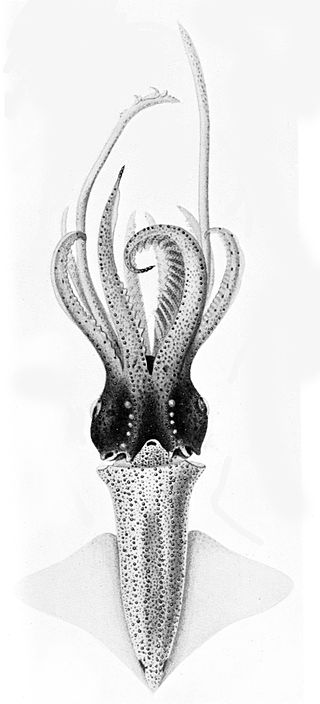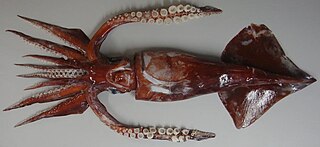
Enoploteuthidae is a family of squid comprising approximately 40 species in four genera. Most species have a mantle length ranging from 3–13 cm (1.2–5.1 in). Hooks are present on all arms and tentacles. The family is best known for the large array of photophores throughout the body.

Ocythoe tuberculata, also known as the tuberculate pelagic octopus or football octopus, is a pelagic octopus. It is the only known species in the family Ocythoidae.

Berryteuthis magister, also known as the magister armhook squid, commander squid or schoolmaster gonate squid, is a medium-sized squid in the family Gonatidae. It is found in cold, high latitude waters of the North Pacific where it is among the most numerous squid species recorded.

Onykia ingens, the greater hooked squid, is a species of squid in the family Onychoteuthidae. It occurs worldwide in subantarctic oceans.

Abraliopsis morisii is a species of bioluminescent squid in the family Enoploteuthidae. The species occurs in tropical to warm temperate waters in the Atlantic Ocean, including the Gulf of Mexico and the Mediterranean Sea. It can be found in the epipelagic and mesopelagic zones. Jean Baptiste Vérany described the species in 1839 and it reaches lengths of 25 to 33 millimetres. It is rated as least concern by the International Union for Conservation of Nature (IUCN).

Illex coindetii, commonly known as the southern shortfin squid or broadtail shortfin squid, is a species of neritic squids in the family Ommastrephidae. They are found in the Mediterranean Sea and on both sides of the north Atlantic Ocean.

Abralia veranyi is a species of squid in the family Enoploteuthidae. Common names include the eye-flash squid, Verany's enope squid and the midwater squid. It is found in the Atlantic Ocean and the Mediterranean Sea. It undergoes a daily vertical migration from deep waters to near the surface.

Abralia andamanica is a species of enoploteuthid cephalopod native to the Indian Ocean and Pacific Ocean. It is known from Australia, Indonesia, Japan and Hawaiʻi. It is associated with shelf waters, and will rise to the upper water column at night to feed. Females spawn eggs 0.9–1.5 mm in diameter in gelatinous strings.

Abralia armata is a species of squid in the family Enoploteuthidae. It is native to waters of Indonesia and the Philippines. A. armata is reported to grow to mantle lengths of up to 2 cm.
Abralia astrolineata is a species of enoploteuthid cephalopod that occurs in the waters around the Kermadec Islands in New Zealand. It is fairly large for this genus, growing up to 100 mm in mantle length.

Abralia astrosticta is a species of enoploteuthid cephalopod present in the waters of Australia, French Polynesia, Japan, New Zealand, the Philippines and Hawaiʻi. They have large ventral photophores. Females carry oocytes 1.0 mm in length in their ovaries.
Abralia fasciolata is a species of enoploteuthid cephalopod that is only known from the Gulf of Aqaba. Mature males can reach a mantle length of 27 mm, with spermatophores 3–3.5 mm in length.
Abralia heminuchalis is a species of enoploteuthid cephalopod native to the equatorial regions of the Pacific Ocean. It may be a junior synonym of A. siedleckyi. Females are larger than males. Oocytes in mature females can reach 1.25 mm in length. Male spermatophores are relatively small at 3.6–4.0 mm in length.
Abralia marisarabica is a species of enoploteuthid cephalopod that is endemic to the Arabian Sea. It may also be present in the Seychelles. It is one of the smallest Abralia species, growing to 19–22 mm (males) and 22–26 mm (females) in mantle lengths. There appears to be sexual dimorphism in the number of arm hooks present.
Abralia omiae is a species of enoploteuthid cephalopod known only from its type locality, the Dimitry Mendeleyev seamount in the Pacific tropics. A. omiae is a small species, less than 3 cm in mantle length.

Abralia redfieldi is a species of enoploteuthid cephalopod ranging across the Atlantic Ocean from the waters of Nova Scotia to Argentina in the west, to the waters of western Africa south to South Africa in the east. It has been caught at depths of 50–100 m at night, and is preyed upon by dwarf sperm whales.
Abralia trigonura is a species of enoploteuthid cephalopod found in the Pacific Ocean in the mesopelagic zone. Females reach a mantle length of 31–35 mm compared to males at 23–27 mm at maturity. Females spawn in batches of 290–430 small eggs, 0.9 mm in length. The paralarvae stage lasts about 40 days before shifting to adult mode. Male spermatophores are relatively small at 7 mm in length. It migrates to the upper water column to feed at night.
Abraliopsis falco is a species of enoploteuthid cephalopod found in the tropical waters of the East Pacific Ocean, and is known from Chile, Colombia, Costa Rica, Ecuador, El Salvador, Guatemala, México, Nicaragua, Panamá, Perú and the United States. Females are larger than males, reaching sizes of 41–46 mm mantle length, with males reaching 35–37 mm mantle length.
Eucleoteuthis is a monotypic genus of squid from the family Ommastrephidae; the only species is Eucleoteuthis luminosa, the striped flying squid or luminous flying squid.

The Antarctic flying squid is a species of squid from the subfamily Todarodinae of the family Ommastrephidae, a family of pelagic squid from the order Oegopsida. It has a circumglobal distribution in the seas around the lower latitudes of the Southern Ocean.












